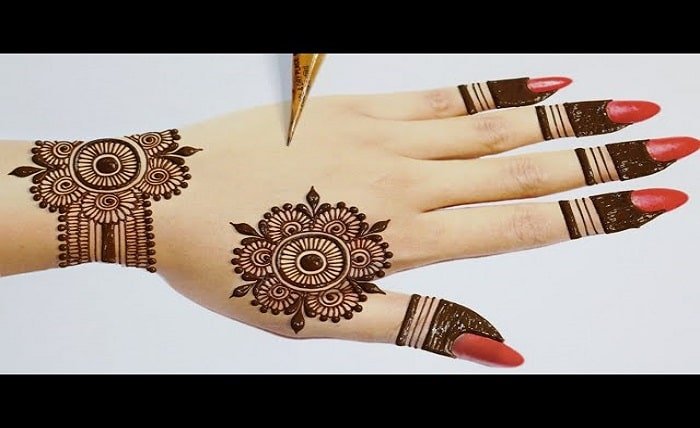Mehandi Ki Design Ideas for Every Occasion – Beautiful, Easy, Stylish & Traditional Designs for Hands, Feet, and Full Body Art

When it comes to Indian weddings, mehandi ki design plays a vital role in the bride’s overall look. A traditional mehandi ki design often includes intricate patterns such as peacocks, flowers, mandalas, and symbols of love. Brides choose a detailed mehandi ki design that extends from their fingertips to the elbow or even higher. These designs reflect cultural heritage and are often customized with the groom’s initials hidden within the mehandi ki design. Applying a traditional mehandi ki design is not just an art but a ritual that brings families together during pre-wedding celebrations.
Simple Mehandi Ki Design for Beginners and Daily Use
If you are a beginner or just looking for something quick and elegant, a simple mehandi ki design is your go-to option. These types of mehandi ki design styles usually include floral motifs, leaves, dots, and vines that are easy to draw and look graceful. A simple mehandi ki design can be used for small functions, college festivals, or even casual outings. Since this type of mehandi ki design doesn’t take much time, it is ideal for people who want beauty with convenience. Even with minimal effort, a simple mehandi ki design adds charm to your look.
Arabic Mehandi Ki Design – Bold, Modern and Gorgeous
An Arabic mehandi ki design stands out due to its bold outlines and flowing patterns. Unlike the dense Indian mehandi ki design, Arabic styles leave spaces between motifs, making the design appear more modern and breathable. Popular Arabic mehandi ki design elements include large floral motifs, leaves, and spirals that usually run diagonally across the hand or foot. This style of mehandi ki design is highly favored for Eid, Diwali, and other festive occasions because of its trendy and attractive appearance. Anyone looking to blend tradition with a contemporary touch can opt for an Arabic mehandi ki design.
Bridal Mehandi Ki Design for Full Hands and Feet
Every bride dreams of the perfect mehandi ki design that completes her bridal avatar. A bridal mehandi ki design is usually dense, covering the entire hand, arm, feet, and sometimes even legs. These designs tell stories, often incorporating the bride and groom’s names, wedding dates, and elements like dulha-dulhan, elephants, and temples. The beauty of a bridal mehandi ki design lies in its detailing and the patience it demands. Applying this kind of mehandi ki design can take several hours but the final result is always breathtaking. It becomes a lifelong memory captured in photographs and hearts.
Kids’ Mehandi Ki Design – Cute, Fun, and Quick Patterns
Kids love colors and patterns, and a cute mehandi ki design makes any festive celebration even more special for them. For children, mehandi ki design options are kept minimal yet playful, often using shapes like stars, smileys, butterflies, and hearts. Since kids have smaller hands and shorter attention spans, a quick mehandi ki design ensures they stay interested and enjoy the process. The use of organic mehndi without chemicals is important when applying a mehandi ki design on kids to avoid any skin irritation. These joyful designs bring a smile to every little one’s face.
Mehandi Ki Design for Festivals like Karwa Chauth, Diwali, and Eid
No Indian festival is complete without applying a beautiful mehandi ki design. Whether it’s Karwa Chauth, Raksha Bandhan, Diwali, or Eid, women across all age groups adorn their hands with a meaningful mehandi ki design. These designs may vary in complexity—from minimalistic wristbands to full-hand patterns depending on the festival’s significance. Applying a festival-inspired mehandi ki design connects you with traditions and adds elegance to your festive attire. Moreover, the mehandi ki design becomes a form of self-expression and joy during celebrations shared with friends and family.
Latest Trends in Mehandi Ki Design for 2025
As fashion evolves, so does mehandi ki design. The latest trends in 2025 are all about fusion designs—mixing Indian and Arabic styles to create something unique. Finger-only mehandi ki design, geometric patterns, and negative space techniques are becoming popular among young women. Another emerging trend is using glitter and colored mehndi to enhance the mehandi ki design. Brides now prefer personalized mehandi ki design that includes initials, hashtags, or even mini portraits. These evolving trends show how the traditional mehandi ki design continues to stay relevant while embracing creativity and modernity.
Mehandi Ki Design for Front and Back Hand
Choosing the right mehandi ki design for both front and back hand is important for a balanced and aesthetic look. The front-hand mehandi ki design often includes heavier and more intricate patterns as it is more visible. In contrast, the back-hand mehandi ki design focuses on elegance, using delicate patterns that complement the front. A well-coordinated mehandi ki design for both sides enhances the overall visual appeal and symmetry. These designs are especially important during weddings and festivals when hands are the center of attention. With a creative mehandi ki design, you can flaunt your hands in style.
Feet Mehandi Ki Design for Brides and Festive Occasions
A beautiful mehandi ki design for feet adds a magical touch to the bridal or festive look. Feet designs are typically drawn on the top surface and extend to the ankles. Popular feet mehandi ki design patterns include mandalas, concentric circles, and peacock tails. The beauty of a feet mehandi ki design lies in its symmetry and the way it complements footwear like juttis or anklets. It’s not just for brides—anyone attending a traditional event can opt for a stunning mehandi ki design for their feet and look absolutely graceful.
Modern Minimalist Mehandi Ki Design for Office and Daily Wear
If you love henna but prefer a more subtle look, a minimalist mehandi ki design is the answer. These designs are ideal for working women or those who prefer less elaborate patterns. A modern mehandi ki design may include a small lotus, a leafy vine, or dots on fingers. These designs are not just time-saving but also match well with western outfits, making the mehandi ki design versatile for all occasions. You don’t need a festival to flaunt a chic mehandi ki design—just your personal style and a little creativity.
Tips to Make Your Mehandi Ki Design Last Longer
After putting effort into applying a beautiful mehandi ki design, it’s essential to make it last. Start by cleaning your hands thoroughly before applying the mehandi ki design. Avoid washing your hands for at least 6–8 hours afterward. Use lemon and sugar dabs to keep the mehandi ki design moist and help it darken. Natural oils like clove and mustard oil can also enhance the richness of your mehandi ki design. Lastly, avoid water and soap for as long as possible to retain the beauty and intricacy of your mehandi ki design.
Mehandi Ki Design Using Cones vs. Stamps vs. Stencils
There are multiple ways to apply a mehandi ki design, depending on your comfort level and experience. The traditional method involves cones, allowing full control over each stroke in your mehandi ki design. For beginners, stamp kits and stencils are great options for achieving a professional look without much effort. Each method offers unique benefits, but the final choice depends on the design complexity and the individual’s skill. Whether you choose a cone or a stencil, the final mehandi ki design should feel personal and beautiful.
Choosing the Right Mehandi Ki Design Based on Occasion
Selecting the right mehandi ki design is essential for matching the tone of the event. For a wedding, go for a grand and elaborate mehandi ki design. For office or casual settings, opt for simple and minimalist styles. Festivals like Eid and Diwali call for elegant Arabic or Indo-Arabic mehandi ki design options. The best part is that you can experiment and combine different mehandi ki design elements to suit your taste and personality. No matter the occasion, the perfect mehandi ki design will enhance your overall appearance.
How to Practice and Improve Your Mehandi Ki Design Skills
If you’re passionate about mastering the art of mehandi ki design, practice is the key. Start with basic shapes and lines before progressing to more complex mehandi ki design elements. Use practice sheets, transparent sheets, or your own hand for drawing regularly. Watch tutorials and observe professional mehandi ki design artists for inspiration. Over time, you’ll develop your style and speed, making you confident in creating your own mehandi ki design masterpieces. Consistency and passion will take your skills to the next level.
Conclusion
The art of mehandi ki design is a timeless tradition that has beautifully evolved with changing fashion and lifestyles. From traditional bridal patterns to modern minimalist styles, mehandi ki design continues to be a cherished part of our cultural expression. Whether you’re celebrating a festival, getting married, or just enhancing your everyday look, the perfect mehandi ki design can uplift your mood and add grace to your personality. With endless creativity, practice, and the right inspiration, you can create a stunning mehandi ki design that speaks volumes about your taste and tradition.
FAQs
1. What is the best mehandi ki design for beginners?
A simple floral or vine mehandi ki design is ideal for beginners due to its ease and elegant appearance.
2. How long does a typical mehandi ki design last?
A well-maintained mehandi ki design can last 7–14 days, depending on aftercare and skin type.
3. Which mehandi ki design is most popular for weddings?
Bridal mehandi ki design with intricate patterns and personalized elements is most popular for weddings.
4. Can I use black mehndi for my mehandi ki design?
While black mehndi enhances contrast, it’s advisable to use natural henna for a safe and skin-friendly mehandi ki design.
5. How can I make my mehandi ki design darker?
Apply lemon-sugar mix, avoid water for a day, and use heat or clove steam to enhance the color of your mehandi ki design.





